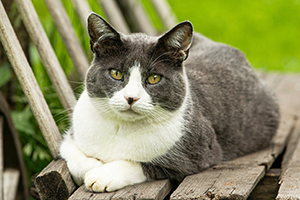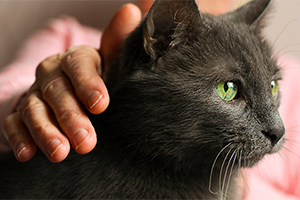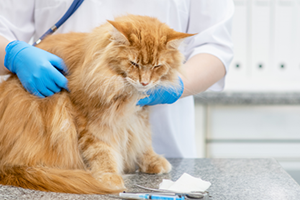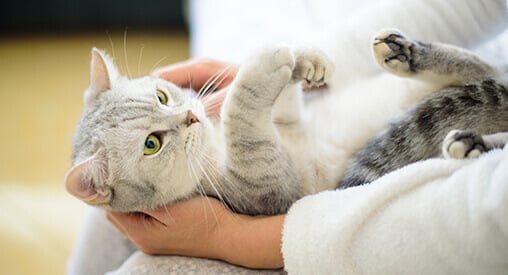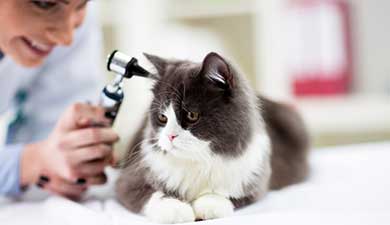How to tell if a cat is in pain
Quick Links
1. My cat is hiding away
There can be many reasons for behavioural changes in cats, but one possibility is that they are experiencing pain. Nobody knows your cat better than you do, so always be alert to any alterations in their normal behaviour and routine. Your cat may start to sleep in new and unusual places or disappear off somewhere dark or secluded where they won’t be disturbed. In the wild, cats tend to hide away when they’re hurt or unwell, to avoid showing weakness in front of predators. Our domestic cats share this natural instinct to protect themselves.
Bear in mind, however, that your cat may also become withdrawn if they’re feeling anxious, stressed or overwhelmed by disruptions in the home. But it is important that medical reasons are ruled out before looking at possible behavioural causes for why a cat might be hiding away.
2. My cat is moving differently
Feline body language can often provide clues to how our cats are feeling. If a cat that is normally healthy and agile seems to have lost their bounce, is moving less freely than usual, or is holding their head in an unusual position, it’s more than likely that something is causing them discomfort.
It’s a good idea to take a video of your cat walking up and down the stairs to show your vet. Vets are experts at looking for any subtle changes in the way your cat moves. Unusual body postures and facial expressions, such as large pupils, flattened ears or a hunched back, can also be indicators of pain in cats. Look out, too, for your pet licking, pawing at or scratching at certain areas of their body that may be hurting, such as their eyes or ears.
3. My cat isn’t grooming normally
Take a close look at any area of your cat’s body that they are repeatedly licking or chewing – this behaviour may be due to an injury or skin irritation hidden in their fur. Over-grooming can be a sign of a cat in pain. For example, a cat may over-groom their groin area and lower inside legs if they are suffering from cystitis.
On the other hand, a cat that stops cleaning themselves and starts to look unkempt may also be experiencing discomfort or infirmity. For example, older cats with arthritis may struggle to groom their back and hindquarters as easily as they did in their younger days.
4. My cat’s eating habits have changed
Watch out for any changes to your cat’s appetite, thirst levels and general eating habits. They may lose their appetite entirely – or, conversely, become agitated and seem desperate for food. If your cat is only eating reluctantly or with difficulty, it could be a sign of painful teeth or gums, or other underlying health problems.
Any changes to your cat’s usual eating and drinking habits, or their weight, should be discussed with your vet.
5. My cat is more or less vocal than usual
Your cat’s vocal communication may alter if they are in pain, both in terms of the kind of sounds they make, and how noisy they are. A cat in pain may meow more or less frequently than usual, perhaps more urgently, or in a different pitch.
They may also make yelping noises, particularly in response to certain movements or to being touched.
Do cats purr when in pain?
6. My cat is having toilet troubles
A sudden aversion to using their litter tray could suggest that your cat is avoiding the place they’ve come to associate with painful peeing or defecating, possibly due to cystitis or a urinary tract infection, or tummy problems.
Oddly coloured or strangely smelling urine, extremely hard stools or diarrhoea can all be signs that something is amiss and your cat may be feeling very uncomfortable as a result.
7. My cat is suddenly aggressive
A normally contented cat who begins to flinch, scratch or bite when stroked could be reacting to pain where you’re touching them. Any sore part of their body, such as an area affected by arthritis, will hurt even more if your affectionate petting hits the wrong spot.
Don’t blame your poor cat for lashing out in pain; their natural instinct is to defend themselves.
8. My cat is less sociable than usual
Any change in your cat’s everyday social interactions needs further exploration. For example, they may no longer want to sit on your lap or come running to greet you when you get home; or a cat that was previously a keen explorer may shy away from going outside.
These could all be signs that your cat is not feeling like their usual self and could be experiencing pain or other health issues. If you’re ever worried about any changing habits or unusual behaviour in your pet, it’s always a good idea to talk to your vet to set your mind at rest – or get your cat the support they need.
Petplan is a trading name of Pet Plan Limited (Registered in England No. 1282939) and Allianz Insurance plc (Registered in England No. 84638), Registered office: 57 Ladymead, Guildford, Surrey GU1 1DB.
Pet Plan Limited is authorised and regulated by the Financial Conduct Authority. Financial Services Register No. 311969. Allianz Insurance plc is authorised by the Prudential Regulation Authority and regulated by the Financial Conduct Authority and the Prudential Regulation Authority. Financial Services Register No. 121849. Pet Plan Limited is a subsidiary of Allianz Insurance plc.


